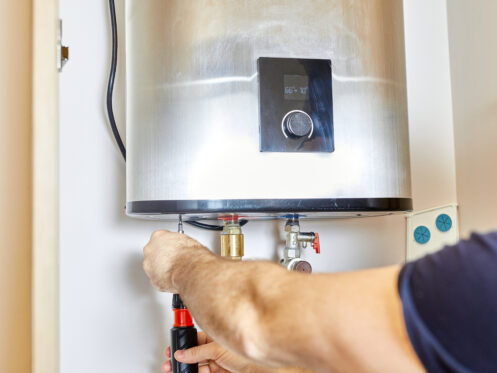The water heater in your Bridgeport, WV home is something you likely don’t think about much—until it fails. At that point, you’ll have to choose its replacement. That’s a decision you’ll have to live with for as long as 20 years. When you start shopping for a water heater, you’ll have two types to choose from. One is the standard storage-tank version, with which you’re likely familiar. The other is a tankless water heater, which you may not know much about. Here’s everything you need to know to choose between the two.
The Basics of Storage-Tank Water Heaters
Storage tank water heaters are available in both gas-powered and electric varieties. Of the two, the former is generally more efficient and less expensive to operate; however, both operate similarly. A storage tank water heater fills from the bottom up. That helps them take advantage of something called stratification. As the heating element at the bottom of the tank heats the incoming water, it naturally rises and gets displaced by more incoming cold water. Once the tank’s thermostat detects that the stored water has reached the required temperature, the heating element turns off. After that, the heating element turns back on as necessary to maintain the stored water’s temperature.
The Advantages of Storage Tank Water Heaters
One of the reasons that storage tank water heaters are popular is that they’re inexpensive. Since they’re the dominant type of water heater in the U.S. market, countless manufacturers make them. That high supply keeps prices low. It also means that replacement parts for storage tank water heaters remain plentiful and inexpensive.
Another advantage of storage tank water heaters is that they’re limited only by storage capacity. In other words, you can use hot water simultaneously in as many places in your home as you wish. The only caveat is that you must wait up to an hour for the heater to replenish its supply once it runs out. Fortunately, a properly sized storage tank should ensure you never run out of hot water.
The Disadvantages of Storage Tank Water Heaters
One of the disadvantages of storage tank water heaters is that they tend to have relatively short lifespans. The average model requires replacement after 12 to 15 years of service. And, they may fail in some destructive ways. For example, a storage tank heater that develops a leak can cause severe damage to your home. If your storage tank heater’s temperature and pressure valve fails, any other malfunction can be disastrous. It can lead to the tank exploding.
Storage tank water heaters also occupy a considerable amount of space. Most are between 50 and 70 inches tall and 20 to 30 inches in diameter. If your home is a high-usage one, you may need an even larger tank. However, if you choose a tank that is larger than necessary, it will operate inefficiently.
The Basics of Tankless Water Heaters
Tankless water heaters are available in both gas-powered and electric varieties. However, only gas-fired models are typically suitable to serve the hot water needs of an entire home. Tankless water heaters operate quite simply. When a tankless heater’s flow sensor detects demand for hot water, its heating element turns on to produce some. Then, the heater continues to run until demand ceases.
The Advantages of Tankless Water Heaters
The most notable advantage of a tankless water heater is its ability to produce an endless stream of hot water. Unlike traditional heaters, a tankless system can never run out of hot water unless you force it to deactivate. Tankless water heaters are also more efficient than conventional storage-tank models. Since they store no water, they don’t suffer standby losses. You can expect a tankless water heater to last for 20 years or more, and they’re less dangerous if they fail.
The Disadvantages of Tankless Water Heaters
Tankless water heaters have only two significant drawbacks. One is that they’re more expensive than their storage tank counterparts. Depending on your needs, a tankless heater may cost two to three times more than a conventional one. The other significant drawback is that tankless water heaters have limited flow rates. So, while they produce an endless stream of hot water, its volume has a limit. Therefore, if you use hot water in multiple locations simultaneously, a tankless heater may struggle to keep up. To solve the problem, you may need to invest more in a larger heater or install multiple units to meet your needs.
Your Trusted Water Heater Specialists
Now that you know the pros and cons of storage tank and tankless water heaters, you can make a more informed decision. However, whichever you choose, you should trust Midstate Plumbing & Air to install it for you. Our trained plumbers have decades of combined experience. And we install only the finest quality water heaters so you get the most out of your investment.
Feel free to read some of our glowing customer reviews, which will give you an idea of what to expect from us. And when you’re ready for a new water heater in Bridgeport, call Midstate Plumbing & Air immediately!
